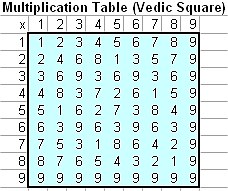<
Previous
|
Next
|
Contents
>
Multiplication Pattern
Consider the following multiplications

You see the pattern of digit sum is repeating as we increase the factor of the multiplication. The pattern of multiplication by 5 is 5-1-6-2-7-3-8-4-9.
How about multiplication by other numbers, will they also form pattern? Try by yourselves and you will find the pattern of digital root like the following table.
|
Multiplication by |
Pattern |
|
|
1 |
1-2-3-4-5-6-7-8-9 |
|
|
2 |
2-4-6-8-1-3-5-7-9 |
|
|
3 |
3-6-9 |
|
|
4 |
4-8-3-7-2-6-1-5-9 |
|
|
5 |
5-1-6-2-7-3-8-4-9 |
|
|
6 |
6-3-9 |
|
|
7 |
7-5-3-1-8-6-4-2-9 |
|
|
8 |
8-7-6-5-4-3-2-1-9 |
|
|
9 |
9 |
If you multiply by 10, 11, 12, 13,... the pattern of digital root will be similar to pattern of multiplication by 1, 2, 3, 4, ... respectively. In other word, the pattern of digital root is repeating by itself. Thus the basic pattern is just from 1 to 9.
Putting this pattern into a table, we will have what is called Vedic square (the name may be related to Indian ancient text of Vedas), as shown in the figure below.

You have seen above the pattern of Multiplication table of digital roots. Now, how do you think of Division, Addition and Subtraction tables of digital roots? Will they have the same pattern or different pattern? Continue to read on the next section to find out
<
Previous
|
Next
|
Contents
>
These tutorial is copyrighted .
Preferable reference for this tutorial is
Teknomo, Kardi (2005). Digital Root. https:\\people.revoledu.com\kardi\tutorial\DigitSum\

